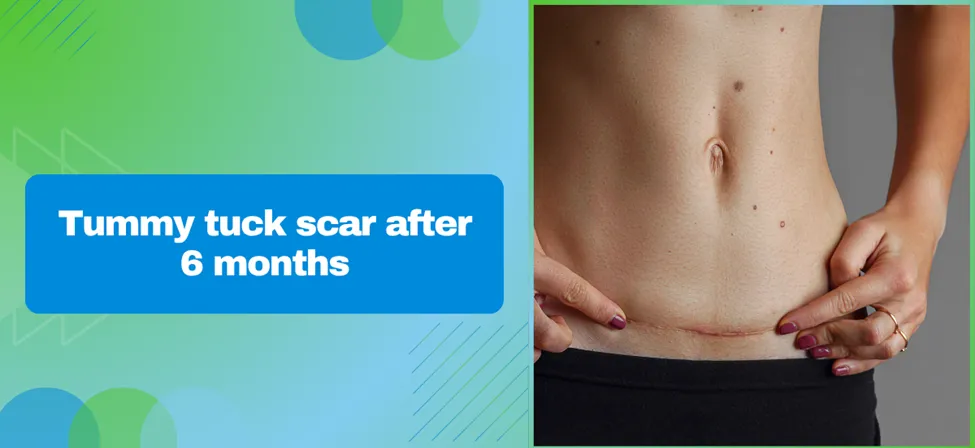A protruding belly can shadow even the happiest moments, affecting how you feel in clothing, at the beach, or even in front of a mirror. When women and men undergo an abdominoplasty (tummy tuck), they’re not just seeking a flatter abdomen—they’re pursuing a renewed sense of confidence. But while the transformation is exciting, the scar that remains raises questions: is it still noticeable? How has it healed? What can you expect at this stage?
Globally, cosmetic procedures like tummy tucks have grown by over 15% in the past five years. In India, there’s been a remarkable 25% increase since 2020. With growing awareness around body aesthetics, more individuals are choosing to redefine their silhouette—and rightly so. However, scar healing remains a vital part of this transformation process.
Dr. Leena Jain, a meticulous Plastic surgeon in Bandra, Mumbai, explains: “The tummy tuck scar after 6 months should be softened and subdued in color. While it may still be visible, it will no longer be red or raised by this stage. It usually lies flat and begins to blend with your skin tone, preparing for the final maturation process over the next months.”
How Tummy Tuck Scars Form?
Scars are the body’s natural response to surgical cuts. Surgeons make a horizontal incision—typically hip-to-hip—to remove excess skin and tighten muscles. How that scar heals depends on:
The incision technique—a low, curved cut that typically sits below your underwear or swimsuit line—helps keep the scar discreet.

Scars are the body’s natural response to surgical cuts. Surgeons make a horizontal incision—typically hip-to-hip—to remove excess skin and tighten muscles. How that scar heals depends on:
The incision technique—a low, curved cut that typically sits below your underwear or swimsuit line—helps keep the scar discreet.
Healing Timeline: From Surgery to 6 Months
Let’s walk step-by-step through what your scar goes through as you recover.
1 Month Post-Surgery
The scar appears fresh: red, firm, possibly swollen or slightly raised.
Scabs and sutures may still be present.
Recommended care: gentle cleaning, wearing compression garments, avoiding heavy lifting and direct sun exposure.
3 Months Post-Surgery
Noticeable reduction in redness and swelling.
Scar begins to flatten and blend with natural skin folds.
It may still feel firm or slightly raised—keloid or hypertrophic tendencies could surface.
Patients are encouraged to massage the scar gently and continue compression to promote softening.
6 Months Post-Surgery
By this time, most scars are flatter, lighter in color, and less visible under clothing.
Slight pink or pale lines may still exist.
The texture should feel more supple, though full maturity could still take up to 18 months.
Factors That Affect Scar Healing
Your tummy tuck scar’s progress depends on a mix of controllable and innate factors. Here’s what plays a role:
Genetics
Everyone’s scar-healing capacity is different. Some people naturally form hypertrophic or keloid scars.
Skin pigmentation
Darker skin types (common in India) are more prone to hyperpigmentation or thicker scarring.
Nutrition and lifestyle
A balanced diet rich in proteins, vitamins, and minerals supports collagen synthesis. Smoking and alcohol, conversely, slow healing and can darken scars.
Post-operative care
Following wound care rules, avoiding sun exposure, and sticking to garment use all help minimize scar formation.
Infection or trauma
If the surgical site becomes infected or undergoes friction (from tight clothing), healing may be delayed and the scar worsened.
How to Improve the Appearance of Your Scar

By the six-month mark, scars are still maturing—and you can actively influence that process:
Silicone sheets or gels:
Widely recommended for flattening and hydrating healing scars.
Gentle massage:
Apply sunscreen and softly massage your scar for 5–10 minutes a day to improve elasticity.
Sun protection:
SPF 30+ and full coverage clothing when exposed to sunlight to prevent darkening.
Topical treatments:
Products with Vitamin E, onion extract (e.g., Mederma®), or prescribed medical-grade creams can enhance healing.
Microneedling or laser therapy:
Considered effective after six months, depending on your healing and under a specialist’s guidance.
Low-level laser or PRP injections:
Often offered by a cosmetic clinic for advanced scar refinement.
By combining these steps, many patients notice their tummy tuck scar become nearly imperceptible over the next 6–12 months.
When to Consult Your Surgeon
If your scar isn’t fading as expected—or worse, worsening—it’s time to reconnect with your specialist. Here’s what to watch for:
- Persistent redness or firmness beyond nine months
- Raised, thick edges that feel firm or itchy (signs of hypertrophy or keloid formation)
- Pain, swelling, oozing, or warmth—possible signs of infection
- Separation of the incision line—even slight—needs prompt evaluation
- Discoloration that doesn’t respond to regular care or sun protection
If you notice any of these, don’t hesitate: seek professional help to explore options like steroid injections or laser-based scar treatments for a neater outcome.
Conclusion
By six months post-abdominoplasty, your tummy tuck scar should be calm, flatter, and softening—though still a maturing line. It won’t be completely invisible, but with patience, optimal care, and occasional professional enhancement, it can become much less noticeable. Remember that every body heals uniquely—it isn’t just the timeline that counts but the quality and consistency of your care.
FAQs
1. Will my scar be completely gone at 6 months?
2. Can I apply sunscreen on my scar once the wound has healed?
3. Do I need to massage my scar?
4. Is it normal for the scar to itch or feel tight?
5. When can I consider laser or microneedling treatments?
References:
https://www.mayoclinic.org/tests-procedures/tummy-tuck/about/pac-20384892
https://myhealth.alberta.ca/Health/aftercareinformation/pages/conditions.aspx?hwid=zc2709
Disclaimer: This page is for informational purposes and not for promotional use.

